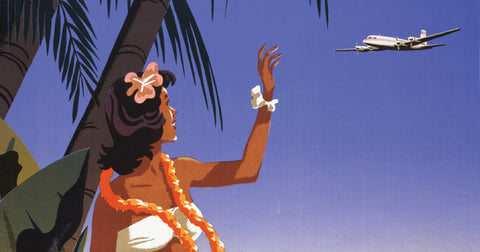
During the Golden Age of Air Travel, These Posters Let You Fly Around the World Without Leaving the Ground
Once upon a time there was a “golden age” of air travel, when passengers wore suits and dresses to fly and airlines created colorful posters to tempt those well-dressed customers to exotic destinations like…Minnesota.
But not just Minnesota. Airlines used posters to tout the appeal of destinations all over the world—and to persuade potential customers that their carriers were the best way to get there.
This was in the days when most people planning a trip had to visit a travel agent. Perhaps an eye-catching poster, one featuring the latest airliner soaring over a scenic vista, would be just the thing to seal the deal.
In his book The Art of the Airways , Geza Szurovy traces the airline poster back to 1914, when the St. Petersburg-Tampa Airboat Line in Florida issued one to promote its “fast passenger and express service.” Early airline posters touted not just the novelty of flight, but also its safety. Once air travel became less novel after World War II, the posters stressed the destination, with the airplanes often reduced to a tiny image streaking across the top. Many of the artists who did these works have retreated into anonymity but some—like David Klein, who created the TWA San Francisco poster on the opposite page—became known for their poster work.
Seeing images like these may make you feel nostalgic for a time when airline travel seemed a little magical. The posters may also make you wistfully contemplate airlines that have vanished, like bird species gone extinct. What remains is the allure of travel—no matter what you’re wearing.
Left: A
Canadian Pacific poster from the 1950s balances the beauty of Hawaii with the
appeal of flying there in a pressurized Douglas DC-6. Right: In a 1950s
offering from Northwest Airlines, New York’s Statue of Liberty remains
impassive as a Boeing 377 Stratocruiser passes overhead. The big propeller-
driven Boeings flew for Northwest until September 1960.
United Air Lines would fly you to Chicago or
Hawaii in one of their Douglas DC-6s.
Left: If United wasn't your airline of choice
for a Chicago trip, try TWA. Right: Canada's airline promised access to the
entire country.
Left: A TWA
Lockheed Constellation approaches L.A. Right: One of the airline's Boeing 707s
passes the Golden Gate Bridge.
Left: Royal Dutch Airlines (KLM) did not really fly wooden shoes. Right: Thai
Airways let you know it preferred conventional airplanes over footwear. Pittsburgh-based Allegheny Airlines is one of
the many carriers that has passed into history. It became USAir in 1979 and
then US Airways until merging with American Airlines.
Pan American World Airways could fly you to New Zealand in a Boeing 314
(left), or to Mexico in a Douglas DC-2 (right).
Braniff Airways became international in 1947 but also flew to U.S.
destinations like Washington. Braniff posters tried to capture the appeal of
domestic destinations, whether it's Jackson Square in New Orleans or the
fishing opportunities in Minnesota, the "Land of Lakes."
Braniff's posters were especially colorful, as
they touted the urban appeal of Chicago or the urban cowboy vibe of Texas.
If South
American was your dream destination, Braniff could get you there, too.
Left: Philippine Air Lines shows potential customers in the 1950s how the
company could send them flying in all directions from Manila. Right: Deutsche
Lufthansa features a Junkers Ju-52 and a winged figure flying over Berlin at
the time of the 1936 Olympics.
Australian National Airlines boasted of its coverage (left), while Qantas
(right) featured its Short S-23 Empire flying boats. Left: A United DC-6 overflies Yosemite. Right:
An American DC-7 soars through Texas.
